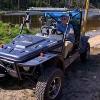Power Steering (Electric)
-
Similar Topics
-
By Frank in MI
Thanks for accepting me!
Haven't got a side by side yet, but have been shopping.
Any advice welcome & I am on a limited budget, so haven't decided yet on new or used.
-
By Justine
I've had a Hisun Vector E1 for just a bit longer than is required for me to do some maintenance. While it's well-overdue, it only drives 1.5km a few times each week on a fairly decent gravel road (to the letterbox), and it has worked really well right from the get-go.
Looking at the manual it states that I need to use SAE80 API GL-4 Hypoid Gear Oil for the Main gear Case, and SAE80 API GL-5 Hypoid Gear Oil for the Front gear Case - unfortunately i can't find either of those online here in Australia. Plenty of options that look close, but, as someone who has never driven any vehicle before, I want to use the right thing and it's a tad confusing.
My question: Since there are no oils that are bang on SAE80 (they all seem to cover a range) would Liqui Moly Hypoid GL4 Gear Oil 80W-90 & Motorex Hypoid GL-5 Gear Oil 80W90 - be ok to use? (Or any other suggestions of what I might be able to purchase online in Australia) And would I have to drain out any existing oil from both gear cases?
This is a whole new world for me and being able to find exactly what is specified in the manual hasn't made this easy!
-
By Poppateets
I just purchased a used 2023 Massimo warrior UTV SxS 1000mx with 600 miles on it. I didn't even get a full day of riding and the driver's side rear axle broke. I'm pretty sure it was already going bad because we would hear a noise once in a while. I'm wondering if anyone else has had problems with theirs. Also looking for places to buy accessories.
-
By Jacob E freeman
I have a 2018 cub cadet challenger 750 I bought brand new almost 2 years ago the first month I had it the exhaust broke and burnt the spark plug wire in two that was a recall so the dealership installed the new one it had a different design and it bolted up to the bottom two plugs below the spark plug the dealership said they had to Adjust the exhaust valves I get the machine back thanking everything is good now wrong not even a week after I get it back the timing chain tensioner comes apart inside the motor I take it back to the dealership They put one on I get the machine back thanking everything is good but then just like before not even a week goes by when I was riding the Machine automatically quits going come to find out the wet clutch was burned up the primary clutch head stripped off of the splines I get that fixed and then it overheats I take it back they bleed the air out of the coolant they bring it back to me the same day that I get it back it overheats again I take it back they temporarily fix it again just enough to let the warranty run out and now the machine has been to multiple different mechanics I have had them try to bleed the air out they have stood it up on its end I have had the water pump changed I have had the fan hooked to a switch so I could leave it on all the time but still almost 2 years later not even 200 hours on the machine and I cannot ride it The dealership will not take it back as a lemon I have tried I am at my wits end I have no clue what to try next
-
By A P
Hi
I have a 2022 hisun sector eps 550. 30amp fuse is blown for eps. Checked the motor and it’s fine. Opened up the controller and found a bad diode. Dealer wanted 500$ for the controller. Just posting this in case it helps someone. I couldn’t read numbers from the old one so just took a guess and replaced it with a 100v 3amp diode.
-







Recommended Posts